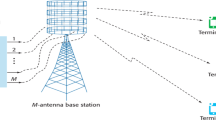Abstract
The study of multi-user multiple-input multiple-output (MU-MIMO) systems has emerged recently as an important research topic because such systems have the potential to combine the high capacity that can be achieved through MIMO processing with the benefits of spatial-division multiple-access. However, receiver and transmitter channel state information (CSI) is generally required, especially for the downlink channel. In this paper, MU-MIMO downlink transmission systems with statistical CSI at the transmitter are studied for jointly correlated MIMO channels. Eigen-mode space division multiple access transmission is derived based on the maximization of the ergodic sum rate, and two eigen-mode power allocation algorithms are proposed using matrix permanent and convex optimization theory. The new algorithms can overcome the limitations of the existing multi-user downlink transmission algorithm in practical applications.
Similar content being viewed by others
References
Telatar I E. Capacity of multi-antenna Gaussian channels. Europ Trans Telecommun, 1999, 10: 586–595
Foschini G J, Gans M J. On limits of wireless communications in a fading environment when using multiple antennas. Wireless Pers Commun, 1998, 6: 311–335
Costa M. Writing on dirty paper. IEEE Trans Inf Theory, 1983, 29: 433–441
Caire G, Shamai S. On the achievable throughput of a multiantenna Gaussian broadcast channel. IEEE Trans Inf Theory, 2003, 49: 1691–1706
Yu W, Cioffi J M. Sum capacity of Gaussian vector broadcast channels. IEEE Trans Inf Theory, 2004, 50: 1875–1892
Weingarten H, Steinberg Y, Shamai S. The capacity region of the Gaussian multiple-input multiple-output broadcast channel. IEEE Trans Inf Theory, 2006, 52: 3936–3964
Vishwanath S, Jindal N, Goldsmith A J. Duality, achievable rates, and sum-rate capacity of Gaussian MIMO broadcast channels. IEEE Trans Inf Theory, 2003, 49: 2658–2668
Viswanath P, Tse D. Sum capacity of the vector Gaussian broadcast channel and uplink-downlink duality. IEEE Trans Inf Theory, 2003, 49: 1912–1921
Jindal N, Vishwanath S, Goldsmith A. On the duality of Gaussian multiple-access and broadcast channels. IEEE Trans Inf Theory, 2004, 50: 768–783
Erez U, Brink S T. A close-to-capacity dirty paper coding scheme. IEEE Trans Inf Theory, 2005, 51: 3417–3432
Jindal N. MIMO broadcast channels with finite rate feedback. IEEE Trans Inf Theory, 2006, 52: 5045–5059
Ding P, Love D, Zoltowski M. Multiple antenna broadcast channels with shape feedback and limited feedback. IEEE Trans Signal Process, 2007, 55: 3417–3428
Yoo T, Jindal N, Goldsmith A. Finite-rate feedback MIMO broadcast channels with a large number of users. In: Proceedings of IEEE International Symposium on Information Theory, Seattle, USA, 2006. 5045–5059
Huang K, Heath R W Jr, Andrews J. Space division multiple access with a sum feedback rate constraint. IEEE Trans Signal Process, 2007, 55: 3879–3891
Sharif M, Hassibi B. On the capacity of MIMO broadcast channel with partial side information. IEEE Trans Inf Theory, 2005, 51: 506–522
Kountouris M, Gesbert D. Memory-based opportunistic multi-user beamforming. Proceedings of IEEE International Symposium on Information Theory, Adelaide, Australia, 2005. 1426–1430
Gao X Q, Jiang B, Li X, et al. Statistical eigenmode transmission over jointly correlated MIMO channel. IEEE Trans Inf Theory, 2009, 55: 3735–3750
Shui D S, Foschini G J, Gans M J, et al. Fading correlation and its effect on the capacity of multielement antenna systems. IEEE Trans Commun, 2000, 48: 502–513
Kermoal J P, Schumacher L, Pedersen K I, et al. A stochastic MIMO radio channel model with experimental validation. IEEE J Select Areas Commun, 2002, 20: 1211–1226
Sayeed A M. Deconstructing multi-antenna fading channels. IEEE Trans Signal Process, 2002, 50: 2563–2579
Weichselberger W, Herdin M, Ozcelik H, et al. A stochastic MIMO channel model with joint correlation of both link ends. IEEE Trans Wireless Commun, 2006, 5: 90–100
Jafar S A, Goldsmith A. Transmitter optimization and optimality of beamforming for multiple antenna systems. IEEE Trans Wireless Commun, 2004, 3: 1165–1175
Cover T M, Thomas J A. Elements of Information Theory. New York: John Wiley & Sons, 1991
Gurvits L. A proof of the log-concavity conjecture related to the computation of the ergodic capacity of MIMO channels. Available at: http://arxiv.org/pdf/0911.0696
Author information
Authors and Affiliations
Corresponding authors
Rights and permissions
About this article
Cite this article
Li, X., Jin, S. & Gao, X. Multi-user MIMO downlink eigen-mode transmission over jointly correlated MIMO channels. Sci. China Inf. Sci. 54, 2124–2137 (2011). https://doi.org/10.1007/s11432-011-4349-x
Received:
Accepted:
Published:
Issue Date:
DOI: https://doi.org/10.1007/s11432-011-4349-x




